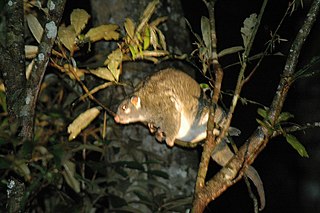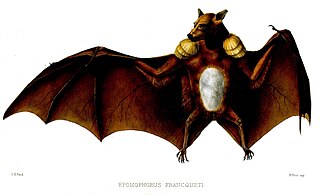
Lontra is a genus of otters from the Americas.

Myospalax is a genus of rodents in the family Spalacidae. It contains these species of zokor:

Paradoxurus is a genus of three palm civets within the viverrid family that was denominated and first described by Frédéric Cuvier in 1822. The Paradoxurus species have a broad head, a narrow muzzle with a large rhinarium that is deeply sulcate in the middle. Their large ears are rounded at the tip. The tail is nearly as long as the head and body.

Hylomys is a small genus of the family Erinaceidae. Hylomys species, like all species in the subfamily Galericinae, are known as gymnures or moonrats. Their closest relatives include the fossil Lantanotherium and Thaiagymnura and the living Neotetracus and Neohylomys. Members of this genus are found in Southeast Asia and Eastern Asia.
Dyacopterus is a genus of megabats from south-east Asia. It contains three species, namely:

Brachylagus is a genus of lagomorph that contains the smallest living leporid, the pygmy rabbit. One extinct species, Brachylagus coloradoensis, is also known.

Suncus is a genus of shrews in the family Soricidae.

Macroglossus is a genus of megabats found in Indonesia and Southeast Asia. It has two species:
The eastern false pipistrelle is a vespertilionid bat that occurs in eastern and south-eastern Australia, including the island of Tasmania.

Nectomys is a genus of rodent in the tribe Oryzomyini of family Cricetidae. It is closely related to Amphinectomys and was formerly considered congeneric with Sigmodontomys. It consists of five species, which are allopatrically distributed across much of South America: Nectomys grandis in montane Colombia; Nectomys palmipes on Trinidad and in nearby Venezuela, Nectomys apicalis in the western margins of the Amazon biome, Nectomys rattus in much of Amazonia, and Nectomys squamipes in the Atlantic Forest of Brazil. These species are generally semiaquatic, are normally found near water, and are commonly called water rats.

Nesoryzomys is a genus of rodent in the tribe Oryzomyini of family Cricetidae, endemic to the Galápagos Islands. Five species have been described, two of them are considered extinct.

Taphozous is a genus of the family Emballonuridae. The wide distribution of the genus includes several regions of Australia, Indonesia, Papua New Guinea and Africa. Taphozous comes from the Greek τάφος, meaning "a tomb". The common names for species include variants on sac-winged, sheathtail, or tomb bats.

False ringtail possums (Pseudochirops) are members of a genus of marsupial in the family Pseudocheiridae. It contains the following species:

Epomops is a genus of bat in the family Pteropodidae. It contains the following species:

Erophylla is a genus of bat in the family Phyllostomidae. It contains the following species:

Harpyionycteris is a genus of megabat in the family Pteropodidae. It contains the following species:

Molossops is a genus of bat in the family Molossidae. The four member species are found in nearly every country of South America, with the dwarf dog-faced bat being found in the most countries. It contains only two species:

Hesperoptenus is a genus of bats within the Vespertilionidae or vesper bat family.

Eidolon is a genus of megabats in the family Pteropodidae. It contains two species:

Dama is a genus of deer in the subfamily Cervinae, commonly referred to as fallow deer.


















